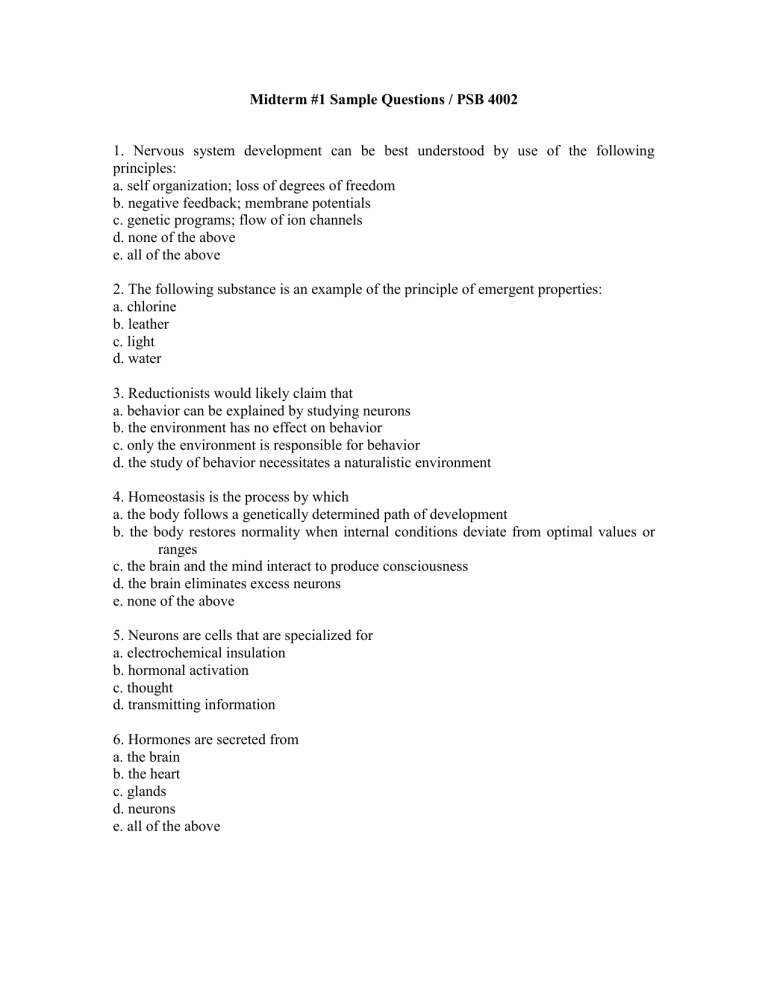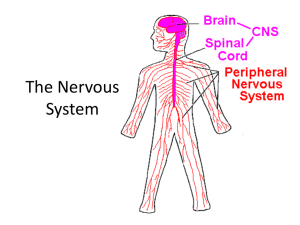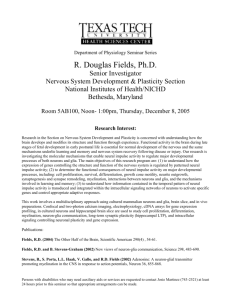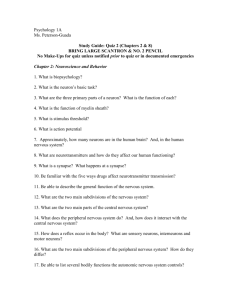Chapter 1

Midterm #1 Sample Questions / PSB 4002
1. Nervous system development can be best understood by use of the following principles: a. self organization; loss of degrees of freedom b. negative feedback; membrane potentials c. genetic programs; flow of ion channels d. none of the above e. all of the above
2. The following substance is an example of the principle of emergent properties: a. chlorine b. leather c. light d. water
3. Reductionists would likely claim that a. behavior can be explained by studying neurons b. the environment has no effect on behavior c. only the environment is responsible for behavior d. the study of behavior necessitates a naturalistic environment
4. Homeostasis is the process by which a. the body follows a genetically determined path of development b. the body restores normality when internal conditions deviate from optimal values or ranges c. the brain and the mind interact to produce consciousness d. the brain eliminates excess neurons e. none of the above
5. Neurons are cells that are specialized for a. electrochemical insulation b. hormonal activation c. thought d. transmitting information
6. Hormones are secreted from a. the brain b. the heart c. glands d. neurons e. all of the above
7. The spinal cord is part of the a. central nervous system b. endocrine system c. exocrine system d. peripheral nervous system e. limbic system
8. The neurons that detect information from events in the external world and transmit it to the central nervous system are called: a. action potentials b. glia c. motor neurons d. sensory neurons e. interneurons
9. The degenerative neural disease that involves the depletion of myelin is: a. cerebral palsy b. Huntington’s disease c. Alzheimer’s disease d. multiple sclerosis
10. Compared to neurotransmitters, the distances traveled by neuromodulators are a. larger b. smaller c. almost the same d.exactly the same, since the terms neurotransmitters and neuromodulators are the same
things
11. The strengthening and weakening of synapses is a product of a. cell death (apoptosis) b. development, experience, and learning c. a one-time, full-strength hormonal release d. reflexes e. mylenation
12. Neurotransmitters and hormones both a. travel great distances b. travel small distances c. are carried in the bloodstream d. affect specific regions of cells that have receptors for them e. none of the above
13. The division of the autonomic nervous system that exerts control over the smooth muscles of the gut is
a. the endocrine system b. the enteric nervous system c. the parasympathetic nervous system d. the sympathetic nervous system
14. Genes cause behavior. a. True b. False
15. The part of the brain concerned principally with memory formation is a. the hippocampus b. the reticular activating system c. the superior colliculus d. the thalamus e. the corpus callosum
16. Axons form __________ at their tip, which sample the environment for directional cues. a. dendrites b. synapses c. CAM molecules d. growth cones
17. By means of muscles and hormones, the ____________ controls the body’s internal environment: a. exocrine glands b. limbic system c. autonomic nervous system d. cerebellum
18. The directional guidance of an axon’s growth appears to be mediated by cues of: a. attraction b. repulsion c. both a and b d. neither a or b
19. During nervous system development, chemoattraction is most influential in a. apoptosis b. neurogenesis c. the production of neurotrophic factors d. the trajectory of the growth cone
20. The autonomic nervous systems is divided in to the sympathetic branch and the
a. True b. False
21. Which of the following is the term for a permanent, or semi-permanent, nonreversible change in the structure of the brain or body that occurs as a result of hormones? a. activational effect b. organizational effect c. closed program d. open program e. homeostasis
22. All of the following are attributes of complexity, EXCEPT a. large number of parts b. hierarchical organization c. linearity d. emergent properties e. significant interaction of parts
23. Which of the following type of neurons is the most common in terms of overall number in the central nervous system? a. interneurons b. sensory neurons c. motor neurons d. mirror neurons e. none of the above
24. Myelin sheaths are found on: a. dendrites b. synapses c. somas d. axons e. all of the above
25. Which of the following processes is NOT associated with the prenatal development of the nervous system? a. migration b. transduction c. differentiation d. cell death








